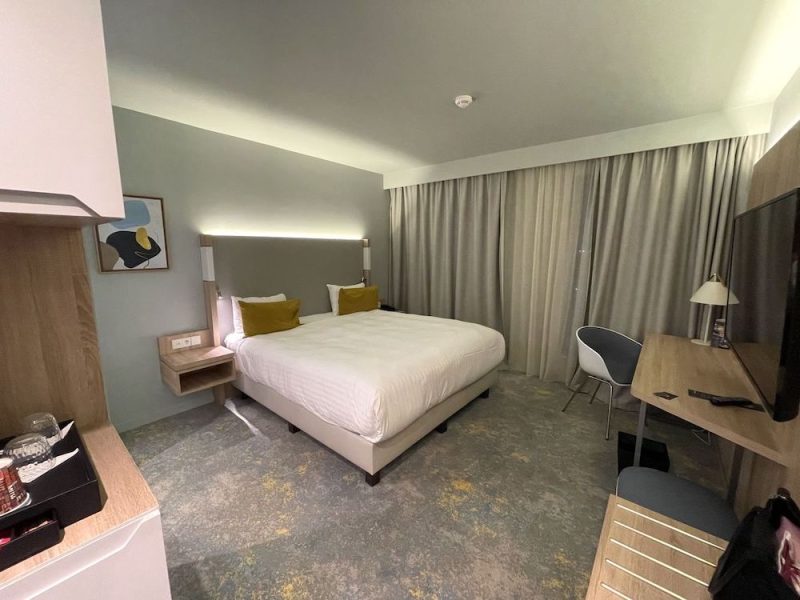How to Plan the Perfect Trip
Culture Travel may earn a commission through links on this website. As an Amazon Associate, we earn from qualifying purchases.
I feel like there are two types of people in the world: those who love planning trips, and those who hate planning trips! I’ll admit I used to be the former, but now I’m the latter!
I used to enjoy researching how to plan a trip and the whole process just got me super excited to travel. Nowadays, I almost wish trips could plan themselves and I could just show up and see everything that needed to be seen!
Of course, that’s not exactly how trips work, so today I’m going to share how to plan the perfect trip, whether you enjoy the process or not!
Choosing a Destination
The first step when planning your trip is to decide on a destination. You may be inspired and have a region or country in mind, or you might know the exact city you want to visit.
With nearly 200 countries in the world, each with different cultures and climates, the possibilities are truly endless.
If this is your first trip abroad, I recommend visiting a Western country like Canada or Western Europe (the UK, Germany, Spain, France, etc). This will help you get accustomed to international travel in a low-risk setting.
Pick a Time
Next up, you’ll need to have at least a general idea of when you want to go. If you can be flexible with the days you travel, this is ideal as you can snag cheaper airfares. But if you’re working around designated school holidays, this might not be possible. If you’re not traveling by air, then the dates don’t matter as much. Airlines are the only major transportation provider you have to worry about crazy varied prices with!
Festival and Special Event Travel
A lot of people like to travel based on the festivals and special events that are taking place in a destination at a certain time, usually once a year.
Here are a few internationally famous events that many people travel to every year:
- Rio Carnival
- Full Moon Party
- Monaco Grand Prix
- Tour de France
- Menton Lemon Festival
- Burning Man Festival
- Oktoberfest
You can also find many exciting events happening around New Year’s Day of different cultures as well as some countries’ Independence Days.
Natural Phenomena Travel
- Cherry Blossoms in Washington D.C.
- African Wildlife Migration
- Lavender Fields in Provence, France
- Green Rice Terraces
- Aurora Borealis
Shoulder Season
For general travel, there tend to be peak and non-peak seasons, mostly based on the weather of that region.
The ideal time to visit a destination is what’s known as the “shoulder” season – the months in between the high and low seasons.
The high season will be too crowded at its peak, and the low season will be too slow. Traveling during the low season means you risk lots of closed attractions and bad weather, so I believe the shoulder season is ideal for getting the best out of your trip.
For example, the high season for travel in Paris is June and July, and the low season is January through April, so an ideal time to visit Paris would be May, September, or October. You have the best chance of having fewer tourists, good weather (not too hot, not too cold), and plenty of things to do.
Each destination has its quirks too, so be sure to research the “Best time to visit (destination)” before settling on that place and time.
For example, you’ll notice I skipped over August when mentioning the best time to visit Paris. Why? Because Paris is quirky in the sense that most businesses and restaurants close down for the month of August to go on vacation elsewhere! You definitely don’t want to plan your trip to Paris in August, even though at first glance it may appear to be the “high season.”
Timing is everything, as they say!
Consider Your Budget
When I first started traveling, I had a super low budget. As my income grew over the years, I slowly began to be able to afford more middle-class vacations and even the luxury splurge from time to time.
Even though I travel well now, I am so thankful I learned how to travel on a budget early on. Knowing what’s worth spending money on and what isn’t can take time and several trips.
If you dream of traveling but don’t have a big budget, don’t worry. Many people travel across the world on a shoestring budget and so can you!
Whatever your budget is, be sure to keep it in mind as you book your flights and hotels.
A lot of the prices will depend on the time of year you travel and how many other people are looking to travel at that time as well. Start researching flights and hotels to get a sense of how much money you will be spending on this trip.
From there, you can shorten or lengthen the trip as needed to fit within your ideal budget.
Visa Requirements
Once you find a good place to go and you know you can afford it, it’s time to research visa requirements.
As Americans, we’re lucky to have visa-upon-arrival access to over 100 countries around the world, but not every country welcomes us with open arms. Right now, Americans can travel to the Schengen Zone Countries in the European Union and receive a visa on arrival, but that will soon change when the ETIAS visa is introduced in November 2023.
Book Your Transportation
Flights can change in price quickly from one day to the next so if you plan on flying to your destination, book the flight first and foremost. Do it as soon as possible. There have been times when I’ve waited too long and literally overnight, a flight jumps in price by 25%!
Google Flights has a great tool called the Date Grid which lets you see the prices for every day a month at a time.
I’ve noticed that flights tend to be the most expensive in the upcoming 2 weeks. Booking 3 weeks out or longer is ideal.
Plan What Places You Want to Visit
Once you have your flights locked in and you know how many days you’ll have in each place, it’s time to decide which places you want to visit!
How Do You Travel?
It’s equally important to consider your travel style!
Do you like to book everything ahead of time or do things on the fly? Do you prefer to organize your days or wander around from place to place without a set itinerary?
Especially if you’re traveling with other people, it’s a good idea to consider the travel styles of everyone before planning your trip in detail. Gather everyone up and throw out some ideas to see what everyone is in the mood to do.
Once you have a sense of how active or relaxed the trip will be, you can start planning out the places you want to visit.
Of course, trip planning is much easier when you’re traveling solo!
Leave a Little Up to Chance
I personally don’t like to plan my days down to the T. What if I stumble across somewhere I want to explore when in town? Leaving some spare time to chance is always a good idea to allow room for last-minute plans.
Get Inspired
Most times you’ll have at least one or two attractions in mind, but you might want to do some more research to discover other must-sees and must-dos.
There are so many ways to find inspiration and decide what you want to visit in each destination. A few of my favorite ways to find cool things to do in each city or country I visit include:
- Google: Do a quick Google search for “best things to do in (destination)” ahead of every trip!
- Pinterest: Type your destination into Pinterest to search for dreamy inspiration!
- Instagram: I always search for the destination I’m heading to on Instagram and look at the Location page to see if any cool photos pop up. What’s great about this is that Instagram pulls all photos that have been tagged in that location such as a hotel or restaurant – not just the city itself! I’ve discovered many cool places in cities this way.
- Google Maps: Take a look at the city in Google Maps and see what they recommend. Oftentimes a new site or attraction pops up as a suggestion here!
- Magazines & Blogs: I love reading curated city guides from cool publications like Goop, Surface Mag, and Suitcase, for example.
Make Reservations at Top Restaurants
If you’re heading to a popular destination at peak travel times, you’ll probably need to make reservations at the city’s best restaurants. I was quite surprised that weekends in a small town in Mallorca, Spain required reservations!
Walk around the city when you first arrive and ask a few restaurants what their reservation policy is. Better yet, ask the hotel staff as soon as you arrive. This will help you avoid getting caught without a place to eat!
Buy Tickets in Advance at Popular Tourist Attractions
Buying tickets in advance for popular tourist destinations is another thing to do as you plan a trip. Oftentimes you can buy tickets to popular sites and museums online, so go ahead and do that as soon as you can!
You may want to rest the first day you arrive in a new place, especially if you are changing time zones, so keep that in mind as you pick a time.
Sometimes we want to be ambitious and squeeze in as much as we can by starting our days early, but this can lead to travel burnout pretty quickly! Allow yourself plenty of time to explore and slowly move about from one place to another. In an unfamiliar destination, this is the smart way to travel!
Pick a Hotel or Accommodation to Stay In
Once you have an idea of the areas you want to visit, it’s time to pick a place to stay!
You might want to choose a hotel near the sites you are most interested in visiting to cut down on transportation time. In major cities, staying near the top attractions can get expensive, so if you’re traveling on a budget, looking for accommodation on the outskirts of town will be more wallet-friendly.
Booking.com is my hotel booking platform of choice. However, I always check the hotel’s own website to see if their direct booking rate is cheaper, and if it’s at least 10% less, I’ll book there.
I used to stay in Airbnbs, but after a bad experience with a host creating a false damage dispute as well as considering the damage done to local housing markets, I decided to stop using the platform.
My general philosophy when it comes to booking hotels is that I’ll be spending the majority of my time outside the hotel so as long as it’s safe and provides a good night’s rest, that’s all I need!
Transportation Logistics
Next up, you have to think about how you’ll get from the airport or train station to your hotel or accommodation.
Some airports offer public transportation between the airport and the city center. While this isn’t the most comfortable way to travel, it’s often the cheapest!
I personally prefer taking taxis from the airport, so I always make sure to have my hotel address on hand.
Use the Notes app to write down your hotel name and address in a large font size to show your taxi driver.
Trip Preparation
Once your transportation and accommodation have been booked, it’s time to do some practical things to prepare for your trip.
Health
Health is something we all take for granted if we’re lucky enough to be overall healthy! Be absolutely sure to look up the health requirements of a particular country well in advance. Do you have all the necessary vaccines and tests? This is something most border control officials take very seriously, so don’t try to get around the rules.
I recommend purchasing travel insurance if you plan to go abroad, too. This can come in handy if you find yourself in a sticky situation in an unfamiliar country.
Lastly, pay extra attention to your health while you travel so you can prevent getting sick!
Staying healthy while traveling is tough but adding some extra fruits and veggies to your diet is a smart move.
Safety
Planning the perfect trip means thinking about your safety too.
Enroll in the US Government’s Smart Traveler Enrollment Program (STEP) if you plan to go abroad.
I always bring an older unlocked cell phone with me in case my main phone gets stolen. I can pop in a local SIM card and continue to stay connected if needed.
I also bring one or two backup credit cards that stay in my hotel room when I go out in case I am robbed. The last thing you want is to be without any way to get money or buy things in the event of an assault or theft.
Thankfully none of this has happened to me, but it’s always better to be safe than sorry!
Money
If you’ve never traveled abroad, then call your bank to find out if they will let you use your debit card abroad. If not, you’ll have to get cash in the currency you need before departing.
Notify your bank that you’ll be abroad, too so they don’t flag any transactions as fraudulent. Call your bank and ask them where to do this. Most banks have the option to do it online! You typically need to enter the country you’re traveling to and the dates you’ll be there. Easy!
Most banks charge a small foreign transaction fee for each international transaction in a currency other than dollars, typically 1-3% of the amount. Be sure to consider this when factoring in your travel budget! These fees can add up fast.
If you plan on traveling abroad often, consider getting a travel rewards credit card with no foreign transaction fees like the Chase Sapphire Reserve or the Bank of America Travel Rewards Card.
You can also get a travel-friendly debit card like the Charles Schwab Investor Checking account or the Capital One 360 card which lets you withdraw cash abroad for free. The Schwab card even reimburses ATM fees worldwide!
Pay in the Local Currency
My biggest money tip when traveling is to always choose the local currency if you are prompted to when paying with an American debit or credit card. In Europe, you’ll choose “Euros” for example, if the credit card machine prompts you.
Some international payment systems offer to charge you in your home currency, but they take a small fee in the process so this almost never works in your favor. Choose the local currency to let your bank determine the conversion rate and save yourself the fee.
Documents
Make sure all your travel documents like your Passport and residency card are up to date and currently valid.
Many destinations won’t allow you to enter the country with less than 6 months of validity on your passport (even if your trip is shorter) so make sure your passport has at least 6 months to go before expiring ahead of your travels.
If not, it’s best to renew your passport before booking a trip.
Take a scan or a picture of your passport and email it to yourself before departing. If your passport gets lost or stolen you can easily report it to your local embassy while abroad.
If you’re traveling to Europe, you can use this photo to prove you’re a foreigner at retailers and get the VAT tax back upon departure for large purchases.
Cell Phones & Data
Most Western airports have free wifi, but ask your cell phone company if they have an international plan available to you before traveling just in case. It’s almost always cheaper to buy a local SIM Card, but you’ll need an unlocked phone to take advantage of local cell phone service. First-time travelers may find it easier to just pay for the extra service from their American cell phone company!
Download an “Offline” Google Map before leaving home to make sure you can get around without data.
Check Your Travel Essentials Stock
While you don’t need to pack for your trip too far in advance, it’s good to think about what you’ll need for the destination you’re visiting.
Ensuring you have your basic travel essentials handy and in stock will give you peace of mind as your trip approaches. It will also give you enough time to order anything you might need.
Here are a few travel essentials you should have:
Most foreign countries have different electricity systems so you’ll almost certainly need an electrical converter if you’re heading abroad. Going hiking? Make sure you have hiking sneakers or boots.
The last thing you want to do is run around at the last minute looking for a new winter coat because you forgot yours ripped last season. Ensure you have everything you need ahead of time so that if necessary, you have the time to shop around for the best price.
When shopping online ahead of trips, I typically like to order items at least 2 weeks in advance of departure to ensure they will be delivered on time.
Learn Some of the Language
It’s helpful to brush up on your language skills before visiting a destination that doesn’t speak English natively!
It will go a long way with the locals and could save you from a bad situation.
It’s always a good idea to make an effort to learn basic phrases of the local language even if most people are accustomed to speaking English to tourists.
I hope this guide on how to plan a trip was useful and you learned a thing or two. Even the most seasoned travelers are always learning things as they go so don’t be upset if your first trip doesn’t go exactly as you planned!
As they say, “expect the unexpected” when it comes to trip planning, and you’ll be just fine!
Happy travels!





